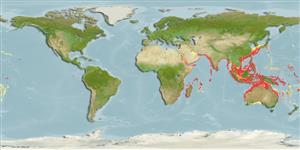Environment: milieu / climate zone / depth range / distribution range
生態学
海; 新鮮な水; 汽水性の 底生の; 降流性の (Ref. 51243); 深さの範囲 20 - 350 m (Ref. 58488). Tropical; 26°C - 29°C (Ref. 4959); 36°N - 35°S, 20°E - 167°W
Indo-Pacific: Red Sea and East Africa to Samoa, north to southern Japan, south to the Arafura Sea (Ref. 9819), Australia, and Lord Howe Island.
Length at first maturity / サイズ / 重さ / 年齢
Maturity: Lm 13.0, range 9 - 17 cm
Max length : 36.0 cm TL オス/雌雄の選別がない; (Ref. 9710); common length : 25.0 cm SL オス/雌雄の選別がない; (Ref. 4967)
背面の脊椎 (合計) : 11 - 12; 背鰭 (合計) : 9 - 11; 肛門の骨: 3; 臀鰭: 7 - 10. Diagnosis: This species is distinguished by the following characters: body oblong moderately and laterally compressed, greatest body depth 2.5-3.2 times in standard length; head length 2.3-2.6 times in standard length; lower opercular spine extending well beyond the opercular flap; posttemporal bone exposed and serrate posteriorly; pectoral fin rays 13-14; gill rakers 6-8 +13-16 = 19-24; pored lateral line scales 75-100; horizontal scale rows above lateral line 13-17; caudal fin emarginate (Ref. 48274, 90102).
Found over shallow sandy bottoms, in the vicinity of river mouths. Enter estuaries and rivers (Ref. 1479, 11230, 44894, 48635), juveniles and adults are often found in freshwater (Ref. 4327). Adults in loose aggregations (Ref. 48635). Juveniles common in sandy intertidal areas; often in tidal pools. Minimum depth reported is 20 m (Ref. 12260). Found in schools (Ref. 9710). Omnivorous (Ref. 7300), feeding on fishes, insects, algae, and sand-dwelling invertebrates (Ref. 9710). Spawn in the sea and juveniles migrate into fresh water (Ref. 2847). Eggs are guarded and fanned by the male parent (Ref. 205). Produce sound (Ref. 9137). Caught on all types of inshore fishing gear including gill nets, traps, handlines, and bottom trawls and marketed fresh and dried-salted (Ref. 48274).
Life cycle and mating behavior
成熟 | 繁殖 | 放精 | 卵 | 生産力 | 幼生
Eggs are guarded and fanned by the male parent (Ref. 205).
Paxton, J.R., D.F. Hoese, G.R. Allen and J.E. Hanley, 1989. Pisces. Petromyzontidae to Carangidae. Zoological Catalogue of Australia, Vol. 7. Australian Government Publishing Service, Canberra, 665 p. (Ref. 7300)
IUCNのレッドリストの状況は (Ref. 130435: Version 2024-1)
Human uses
水産業: 少数商業の; 水産養殖: 商業
用具
特記事項
XMLをダウンロードして下さい
インターネットの情報源
Estimates based on models
Preferred temperature (Ref.
123201): 17.6 - 27.9, mean 23.7 °C (based on 917 cells).
Phylogenetic diversity index (Ref.
82804): PD
50 = 0.6250 [Uniqueness, from 0.5 = low to 2.0 = high].
Bayesian length-weight: a=0.01585 (0.01280 - 0.01963), b=3.02 (2.96 - 3.08), in cm total length, based on LWR estimates for this species (Ref.
93245).
栄養段階 (Ref.
69278): 3.9 ±0.5 se; based on diet studies.
Generation time: 4.6 ( na - na) years. Estimated as median ln(3)/K based on 2
growth studies.
回復力 (Ref.
120179): 手段, 1.4年~4.4年の倍増期間の最小個体群 (K=0.24).
Fishing Vulnerability (Ref.
59153): Moderate vulnerability (37 of 100).
Nutrients (Ref.
124155): Calcium = 116 [71, 223] mg/100g; Iron = 1.11 [0.71, 1.75] mg/100g; Protein = 18.4 [17.5, 19.2] %; Omega3 = 0.306 [0.183, 0.494] g/100g; Selenium = 62.8 [32.1, 121.9] μg/100g; VitaminA = 37.9 [14.6, 97.9] μg/100g; Zinc = 1.19 [0.84, 1.68] mg/100g (wet weight);
